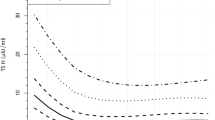Abstract
Background
Neonatal thyrotropin (TSH) is influenced not only by the infant’s own thyroid function, but also by maternal thyroid status, and can thus provide a general index of thyroid health in the community.
Methods
In 2012, the Republic of Armenia implemented a program of universal neonatal hypothyroidism screening by means of measuring the serum TSH level. The Arabkir Medical Center in Yerevan, Armenia, has maintained records of neonatal TSH screening data comprising nearly 100% of all births in Armenia from 2012 through 2016. We analyzed these data to determine the frequency of neonatal TSH levels higher than the cut point of 5 mIU/L, indicative of sufficient iodine nutrition status, and to detect any time dependence over years or regional variation.
Results
A total of 127,177 records from 2012 to 2016 were included. The geographic distribution of neonatal TSH records was reflective of the population of Armenia; the national percentage of records over 5 mIU/L ranged from a high of 2.88% in 2012 to a low of 1.71% in 2016. Minimal regional variation was noted, from a 2012–2016 cumulative high of 2.93% of records over 5 mIU/L in Shirak province to a low of 0.95% in the Vayots Dzor province.
Conclusions
From all years and from all regions, values were consistently and uniformly below the cut point of 5 mIU/L. These results show no evidence of iodine deficiency in Armenia, and suggest that neonatal TSH may be a useful tool for monitoring iodine nutrition in Armenia.
This is a preview of subscription content, access via your institution
Access options
Subscribe to this journal
Receive 12 print issues and online access
$259.00 per year
only $21.58 per issue
Buy this article
- Purchase on Springer Link
- Instant access to full article PDF
Prices may be subject to local taxes which are calculated during checkout



Similar content being viewed by others
References
Jameson J, Mandel SJ, Weetman AP. Disorders of the thyroid gland. In: Kasper D, Fauci A, Hauser S, Longo D, Jameson J, Loscalzo J, editors. Harrison’s principles of internal medicine, 19e. New York, NY: McGraw-Hill; 2014.
Li M, Eastman CJ.Neonatal TSH screening: is it a sensitive and reliable tool for monitoring iodine status in populations?’ Best Pract Res Clin Endocrinol Metab. 2010;24:63–75.
World Health Organization. Assessment of iodine deficiency disorders and monitoring their elimination: a guide for programme managers. 3rd ed. Geneva: World Health Organization; 2007.
Rose SR, Brown RS, Foley T, Kaplowitz PB, Kaye CI, Sundararajan S, et al. Update of newborn screening and therapy for congenital hypothyroidism. Pediatrics. 2006;117:2290–303.
Delange F, Dalhem A, Bourdoux P, Lagasse R, Glinoer D, Fisher DA, et al. Increased risk of primary hypothyroidism in preterm infants. J Pediatr. 1984;105:462–9.
Lott JA, Sardovia-Iyer M, Speakman KS, Lee KK. Age-dependent cutoff values in screening newborns for hypothyroidism. Clin Biochem. 2004;37:791–7.
Working Group on Neonatal Screening of the European Society for Paediatric Endocrinology. Revised guidelines for neonatal screening programmes for primary congenital hypothyroidism. Horm Res. 1999;52:49–52.
Theodoropoulos T, Braverman LE, Vagenakis AG. Iodide-induced hypothyroidism: a potential hazard during perinatal life. Science. 1979;205:502–3.
World Health Organization. WHO Indicators for assessing iodine deficiency disorders and their control through salt iodisation. Geneva: WHO; 1994. WHO/NUT/94.6
Burns R, Mayne PD, O’Herlihy C, Smith DF, Higgins M, Staines A, et al. Can neonatal TSH screening reflect trends in population iodine intake? Thyroid. 2008;18:883–8.
Ghazarian HG. On peculiarities of thyroid gland in inhabitants of three different areas of the Armenian SSR. J Exp Clin Med. 1979;2:115–22.
Karamian RK. On the state of the thyroid glands in inhabitants of Zangezour regions of the Armenian SSR. J Exp Clin Med. 1981;1:74–77.
Rossi L, Branca F. Salt iodisation and public health campaigns to eradicate iodine deficiency disorders in Armenia. Public Health Nutr. 2003;6:463–9.
Government of Armenia Decree # 353-N of 12 February 2004.
Ministry of Health. Report on results of national representative survey of iodine nutrition and implementation of Universal Salt Iodization Program in Armenia. Yerevan: Ministry of Health of the Republic of Armenia & UNICEF Representative Office in Armenia; 2005.
Hutchings N, Aghajanova E, Baghdasaryan S, Qefoyan M, Sullivan C, He X, al. Iodine nutrition in Armenia: a model of representative surveillance. [Abstract] In: 87th Annual Meeting of the American Thyroid Association; 17-22 Oct 2017; Victoria, Canada.
Hovespyan M, Tovmasyan I, Babloyan A. Laboratory organization of the newborn hypothyroid screening program. Yerevan: Arabkir Medical Complex – Child and Adolescent Health Institute; 2006. (Original in Armenian)
Zimmermann M. EUthyroid research protocol.. Zürich: Eidgenössische Technische Hochschule Zürich; 2013.
Vandevijvere S, Coucke W, Vanderpas J, Trumpff C, Fauvart M, Meulemans A. et al. Neonatal thyroid-stimulating hormone concentrations in Belgium: a useful indicator for detecting mild iodine deficiency?. PLoS ONE. 2012;7:e47770
National Statistical Service, Republic of Armenia. Census 2011 – Initial results. NSS RA: Yerevan; 2012 (Original in Armenian)
Acknowledgements
We gratefully acknowledge Dr. Gregory Gerasimov of the Iodine Global Network and Diana Andreasyan of the Armenian National Institute of Health, as well as the staff of the Neonatal Hypothyroid Screening Program at Arabkir Medical Center. This study was made possible with support from the Iodine Global Network and the MD/MS in Biomedical Sciences (Global & Population Health Focus) of the Columbia University Center for Global and Population Health, with additional support from the Fulbright US Student Program, the John and Hasmik Foundation, and the Anna and Hirair Hovnanian Foundation, and with the collaboration of the Arabkir Medical Center and the Ministry of Health of the Republic of Armenia.
Author information
Authors and Affiliations
Corresponding author
Ethics declarations
Conflict of interest
The authors declare that they have no conflict of interest.
Rights and permissions
About this article
Cite this article
Hutchings, N., Tovmasyan, I., Hovsepyan, M. et al. Neonatal thyrotropin (TSH) screening as a tool for monitoring iodine nutrition in Armenia. Eur J Clin Nutr 73, 905–909 (2019). https://doi.org/10.1038/s41430-018-0298-4
Received:
Revised:
Accepted:
Published:
Issue Date:
DOI: https://doi.org/10.1038/s41430-018-0298-4



